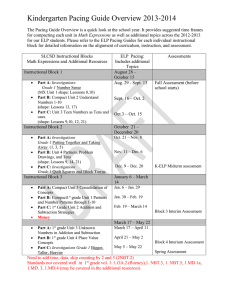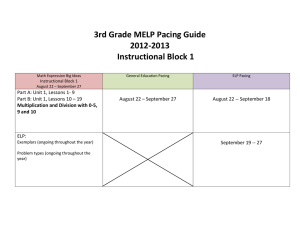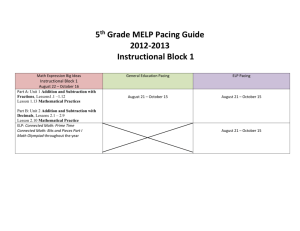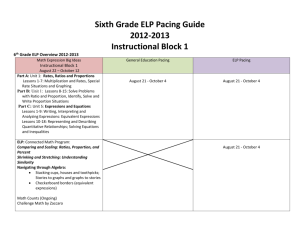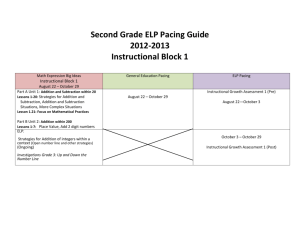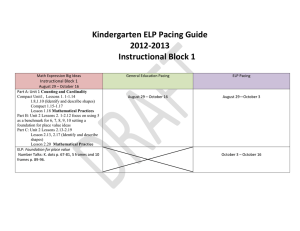Pacing Guide Overview
advertisement
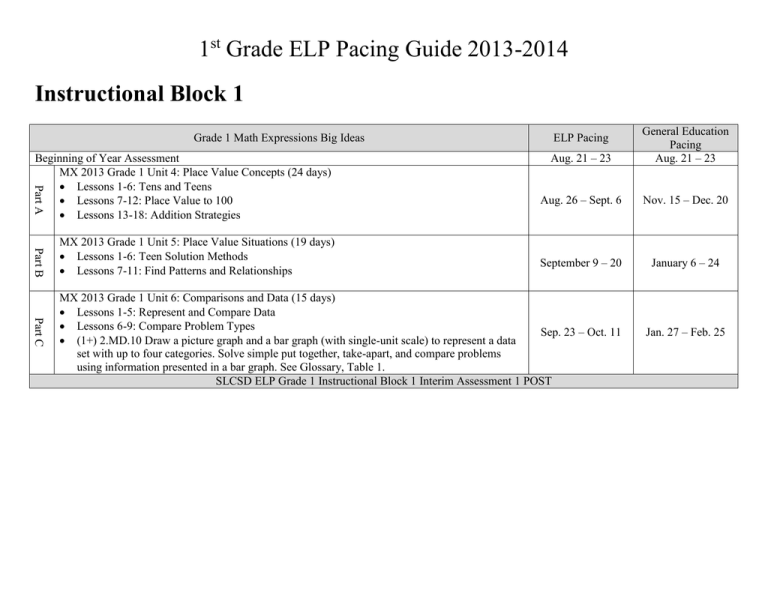
1st Grade ELP Pacing Guide 2013-2014 Instructional Block 1 Grade 1 Math Expressions Big Ideas Part A Beginning of Year Assessment MX 2013 Grade 1 Unit 4: Place Value Concepts (24 days) Lessons 1-6: Tens and Teens Lessons 7-12: Place Value to 100 Lessons 13-18: Addition Strategies Part B MX 2013 Grade 1 Unit 5: Place Value Situations (19 days) Lessons 1-6: Teen Solution Methods Lessons 7-11: Find Patterns and Relationships Aug. 21 – 23 General Education Pacing Aug. 21 – 23 Aug. 26 – Sept. 6 Nov. 15 – Dec. 20 September 9 – 20 January 6 – 24 ELP Pacing Part C MX 2013 Grade 1 Unit 6: Comparisons and Data (15 days) Lessons 1-5: Represent and Compare Data Lessons 6-9: Compare Problem Types Sep. 23 – Oct. 11 (1+) 2.MD.10 Draw a picture graph and a bar graph (with single-unit scale) to represent a data set with up to four categories. Solve simple put together, take-apart, and compare problems using information presented in a bar graph. See Glossary, Table 1. SLCSD ELP Grade 1 Instructional Block 1 Interim Assessment 1 POST Jan. 27 – Feb. 25 1st Grade ELP Pacing Guide 2013-2014 Instructional Block 2 Grade 1 and Grade 2 Math Expressions Big Ideas ELP Pacing General Education Pacing Part A MX 2013 Grade 1 Unit 7: Geometry, Measurement, and Equal Shares (23days) Lessons 1-5: Tell and Write Time (1+) 2.MD.7 Tell and write time from analog and digital clocks to the nearest five minutes, using a.m. and p.m. Lessons 6-11: Shapes and Equal Shares Lessons 12-14: Measure and Order by Length *Transitivity Principle for Indirect Measurement Oct. 14 – Nov. 1 Feb. 26 – March 18 Part B MX 2013 Grade 1 Unit 8: Two-Digit Addition (10 days) Lessons 1-6: Add 2-Digit Numbers (1+) Partners of 100. For any number 1 to 99, find the number that makes 100 when added to the given number, e.g., by using objects or drawings, and record the answer with a drawing or equation. (1+) Equivalent Representations. Compose and decompose any number 1 to 100 using equivalent representations, other than the minimum grouping (expanded form). For example, show 63 with 18 pieces. Nov. 4 – Nov. 15 March 19 – 27 Part C MX 2013 Grade 2 Unit 1: Addition and Subtraction Within 20 (29 days) Lessons 1-9: Strategies for Addition and Subtraction Nov. 18 – Dec. 20 Lesson 10-16: Addition and Subtraction Situations Lessons 17-21: More Complex Situations SLCSD ELP Grade 1 Instructional Block 2 Interim Assessment 2 POST N/A 1st Grade ELP Pacing Guide 2013-2014 Instructional Block 3 ELP Pacing General Education Pacing January 6 – 31 N/A February 3 – 14 N/A February 18 – 28 N/A Grade 2 Math Expressions Big Ideas Part A MX 2013 Grade 2 Unit 2: Addition Within 200 (23 days) Lessons 1-5: Use Place Value Lessons 6-10: Add 2-Digit Numbers Lessons 11-15: Money and Fluency for Addition Within 100 Focus on PLACE VALUE Part B (1+) 2.NBT.1 Understand that the three digits of a three-digit number represent amounts of hundreds, tens, and ones; e.g., 706 equals 7 hundreds, 0 tens, and 6 ones. Understand the following as special cases: a. 100 can be thought of as a bundle of ten tens — called a “hundred.” b. The numbers 100, 200, 300, 400, 500, 600, 700, 800, 900 refer to one, two, three, four, five, six, seven, eight, or nine hundreds (and 0 tens and 0 ones). (1+) 2.NBT.2 Count within 1000. (1+) 2.NBT.3 Read and write numbers to 1000 using base-ten numerals, number names, and expanded form. (1+) 2.NBT.4 Compare two three-digit numbers based on meanings of the hundreds, tens, and ones digits, using >, =, and < symbols to record the results of comparisons. (1+) 2.NBT. 8 Mentally add 10 or 100 to a given number 100–900, and mentally subtract 10 or 100 from a given number 100–900. Focus on SUBTRACTION (9 days) Part C RESOURCE: Math Talks (pgs. 119-154) o Include open number line, mental math, and other strategies (1+) 2.OA.1 Use addition and subtraction within 100 to solve one- and two-step word problems involving situations of adding to, taking from, putting together, taking apart, and comparing, with unknowns in all positions, e.g., by using drawings and equations with a symbol for the unknown number to represent the problem. See Glossary, Table 1. (1+) 2.NBT.5 Fluently add and subtract within 100 using strategies based on place value, properties of operations, and/or the relationship between addition and subtraction. SLCSD ELP Grade 1 Instructional Block 3 Interim Assessment 3 POST 1st Grade ELP Pacing Guide 2013-2014 Instructional Block 4 ELP Pacing General Education Pacing March 3 - 21 N/A March 17 – 28 N/A Mar. 31 – Apr. 11 N/A Grade 2 Math Expressions Big Ideas Part A Part B MX 2013 Grade 2 Unit 3: Length and Shapes (16 days) Lessons 1-5: Length and Shapes Lessons 6-9: Estimate, Measure, and Make Line Plots 1(+) Congruence. Demonstrate the meaning of congruence through analysis of different perspectives, orientations, and transformations of shape. Determine whether two polygons are congruent by physically fitting one on top of the other. Students do not need to use formal names for transformations. 1(+) Symmetry. Analyze the structure of shapes and how they can be decomposed or put together using ideas of symmetry. ADDITIONAL TOPICS: Ideas: Part C ADDITIONAL TOPICS: Ideas: SLCSD ELP Grade 1 Instructional Block 4 Interim Assessment 4 POST ADDITIONAL TOPIC IDEAS: number lines (open and scaled), exemplars, skip counting, investigations, polygons
